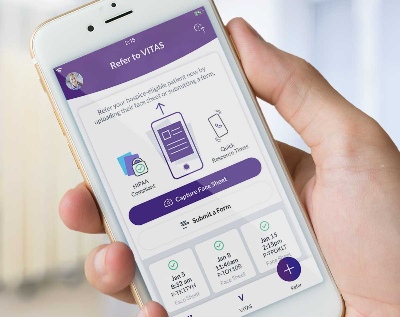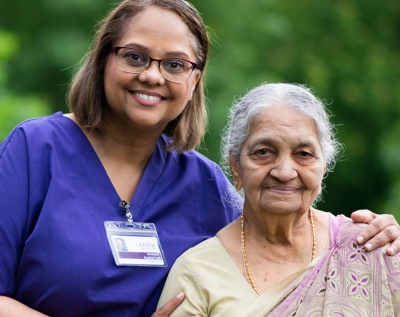Compassionate Care, Free From Judgment: Validating LGBTQ+ Hospice Patients
To create truly individualized hospice care plans, compassionate healthcare providers and care teams must understand and respect their patients’ different cultures, religions, traditions, languages, and sexual identities without judgment or discrimination.
VITAS leads the way in inclusive care for LGBTQ+ hospice patients, a longstanding commitment that makes a real difference in providing patient-centered end-of-life care for them and for their partners and families.
“LGBTQ+ people continue to experience discomfort when accessing healthcare, and that is heightened when one becomes more vulnerable, such as at the end of life and in hospice,” says Joseph Shega, MD, VITAS chief medical officer. “We need to be aware of that, address it in a thoughtful, compassionate, and caring way, and respect whatever they decide.”
In recognition of LGBT History Month in October, VITAS experts endorse these best practices that support respectful, dignified, and informed care for patients who identify as LGBTQ+, and for their partners and families.
Tips for LGBTQ+ Healthcare:
- Make no assumptions about a person’s sexual identity. The landscape of sexual identity, gender, and sexual orientation is broad and evolving, so be careful not to mis-gender or mis-identify patients.
- If you’re unsure of a patient’s sexual identity, ask simple questions: How do they wish to be identified? What are their pronouns? What words should you use and not use? How should you refer to their partner? Common pronouns are she/her, he/him, they/them, zie (pronounced “zee” and replaces she/he/they) or hir (pronounced “here” and replaces her/hers/him/his/they/theirs); or ask patients directly if there are others they use.
- Similarly, make no assumptions about whether a person has divulged their sexual identity to everyone who visits, including family and friends. Give each patient space to explain their disclosure, defer to their decisions about who knows what, and respect their privacy during each visit/encounter, especially when others are in the room/vicinity.
- When involving family members, ask direct questions about whether family members are a patient’s birth/related family or the friends/partners they have chosen as their family members, usually because of rejection by their biological family. Based on their responses, involve them accordingly. Know who is the legally designated representative for a patient’s healthcare decisions.
- Be aware of generational differences in LGBTQ+ language. Example: Some younger couples might call themselves “husbands” or “wives,” while some older couples might prefer the term “partners.”
- Let the patient and partner/family set the stage for the care they prefer. Listen with an open mind and take cues from them about how much information they are willing to provide and when they feel comfortable divulging it.
Psychosocial Care Guidelines for LGBTQ+ Patients
- Identify current sources of stress for each patient (e.g., family conflicts, lack of/partial/full disclosure, isolation, estrangement, rejection, alienation, loss, depression, anxiety, etc.).
- Encourage involvement in activities that build resilience and help patients cope (e.g., support groups, meditation, community involvement, journaling, volunteering, the arts, etc.).
- Be willing to let your patient educate you about their emotional or psychological issues. Ask for clarification if you don’t understand.
- Understand that interacting with LGBTQ+ patients’ biological families can be challenging, especially if they are dealing with the patient’s illness and issues of the patient’s sexual identity, disclosure, or lifestyle. When possible, connect families/friends with supportive community resources, such as PFLAG (Parents and Friends of Lesbians and Gays) or GLAAD (Gay & Lesbian Alliance Against Defamation).
- Remind patients to update and sign all legal documents about their care so that their wishes are honored.'
- Avoid judgment when caring for patients who are HIV-positive; treat them with the same level of compassion as you treat other patients with life-limiting illnesses.
Spiritual Care Guidelines for LGBTQ+ Patients
- Be aware that some patients may have had negative experiences with formal religion or religious leaders, especially denominations that condemn LGBTQ+ identities. Provide a welcoming space for exploring their feelings and past experiences, and take direction from them about how to proceed.
- Discuss healthy spirituality and connect patients/partners with compassionate chaplains and churches, synagogues, and other faith communities that openly accept LGBTQ+ people.
- Be prepared for feelings of guilt, shame, anger, and rejection (“Why doesn’t God love me?” “Why do some people feel I’m a sinner?” “How can the way I’ve been rejected be God’s will?”). Help them explore which feelings should be challenged and overcome.
- Discuss with patients how they want their memorial service to be conducted, and what information they want included/excluded from their memorial service and obituary.
Guidelines for Care of Transgender Patients
As they’re examining or caring for transgender patients, hospice nurses and aides are more likely than other members of the interdisciplinary team to encounter human bodies that have undergone or are undergoing a hormonal and/or surgical transition from male to female or from female to male.
- Keep thoughts to yourself and silent during physical examinations when you encounter scars, tattoos, or other anatomical markers that indicate completed or ongoing transition (e.g., breast reconstruction/mastectomy, genital surgery, etc.). Instead, take cues from your patient and assess their comfort level with divulging information or answering questions. Ask simple questions to gather the relevant information you need for each patient’s hospice care.
- Pay attention to patients’ reactions during physical examinations, keeping in mind that some—especially women—have been victims of sexual violence. Simple acts of care, including a touch, giving a bath, or conducting a physical exam, can trigger traumatic emotions and experiences. Give patients the space, privacy, and supportive resources they need if these kinds of reactions or emotions arise.
- Remember: the degree and manner of an individual’s transition is a personal choice. Many transgender people elect not to pursue gender-affirming surgeries or hormonal treatments. Others are barred from these measures by circumstance. Affirm your patient’s gender identity by using pronouns based on their usage rather than your perception/assumption.
Upcoming Webinars for Healthcare Professionals

The VITAS Advantage
By choosing VITAS for your hospice and palliative care needs, you, your patients or residents, and their families realize benefits that other providers cannot offer.
Learn More

